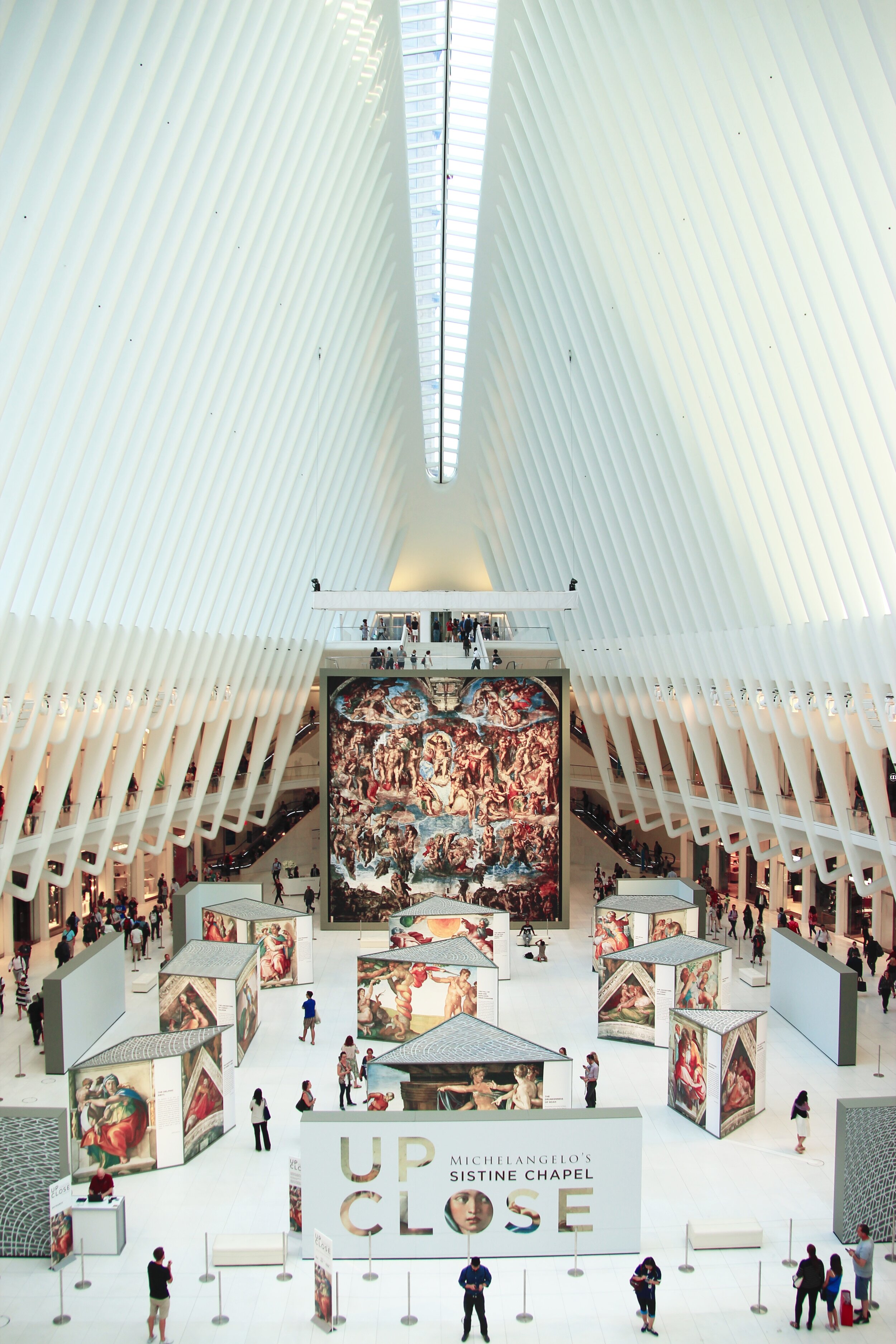Lately, I can’t stop thinking about the strange, striking similarities between our own, current era and the Renaissance. This connection is partially why I wrote my novel, Oil and Marble — to explore what the Renaissance can teach us about our world today.
I attended the exhibition (pictured to the left) at the Oculus — of Michelangelo’s Sistine Chapel Up Close — and it really struck me how AT HOME Michelangelo’s imagery seems in our modern world…
So, after studying the Renaissance for nearly 25 years, here are my distilled Top 10 Ways Our World is Like the Renaissance.
1: Democratization of Information: We have the internet, but the Renaissance had the printing press. Gutenberg printed and sold his first Bibles in 1455; for the first time, information spread out of churches and schools. They had the same concerns we do: would this new “technology” change brains and society for the worse or would it free the world from the powers of the elite?
2: Dirty Politics: We aren’t the only era rife with political anger. The Renaissance was a time of particular political strife. The good news? If you’re concerned about the state of our politics, remember that the Renaissance had King Henry VIII (pictured to the left), Machiavelli, Isabella I, King Ferdinand — tyrants and manipulators who regularly beheaded their enemies (and wives!) and advocated for ruthless self-empowerment. Battling factions went to literal war—I’m talking the cannon-firing, killing and raping kind of war—rather than just arguing it out on Twitter. Although both eras have dirty politics at our centers, the rulers of the Renaissance make our current antagonism seem downright reasonable.
3: Nationalism versus Globalism: During the Renaissance, people from beyond homeland borders were considered barbarians. On the other hand, these were the years when Columbus was sailing the Ocean blue and new lands were being discovered… Our current debate over closing borders or embracing the world is nothing new.
4: Alternative Facts and Fake News: One of the reasons I find the Renaissance so fascinating is because it was the heyday of spin. Take JUST ONE example: Pope Julius was known as Papa Terrible and the Warrior Pope, but late in his career, he needed his people to trust and love him. Check out this portrait by Raphael. Does Pope Julius look like a screaming, cursing warrior who would strike you over the head with a stick at any moment for disagreeing with him? No. Because this pope — and this era — was just as addicted to spin as we are!
5: Me-Centered Culture: Today we have selfies and social media, but it’s not much different than the rise of Humanism during the Renaissance. Gone were the days of focusing on spiritual matters; suddenly MAN was at the center of every conversation.
6: Idealism of the Past: The Renaissance was all about climbing out of the so-called “Dark Ages” and bringing about the rebirth of ancient culture (see Raphael’s School of Athens to the right for a very clear example of this ideal). Today, many of our people look backwards to some sort of ideal, too. It’s a natural human inclination, even if it is impossible to truly recapture the past.
7: Fame Obsessed: With the Renaissance came the rise of celebrity. With the likes of Donatello, Botticelli, Leonardo da Vinci, Michelangelo, and Raphael (most pictured in School of Athens above; most Teenaged Mutant Ninja Turtles today) suddenly an artist’s name — and fame — mattered when commissioning a work. Our modern-day obsession with celebrity culture is nothing more than a five-hundred year old obsession.
8: Joining of Art and Science: The Renaissance is famous for joining together the worlds of art and science to make advances never before imagined. Today, arts and sciences are joining hands once again as they stand together to support science and arts education. As these two forces work together — in Silicon Valley and beyond — imagine the Renaissance Men and Women that might emerge.
9: Hubs of Creativity: Speaking of Silicon Valley… Vibrant centers of creativity were central to the advancements of the Renaissance. San Francisco is a modern-day Florence, a hub of creative, brilliant people, coming together to create new things. When a bunch of ambitious people work side by side in the same city, they all strive to outdo each other — and thereby create marvels.
10: Explosion of Invention: The Internet and Silicon Valley have no doubt changed the world. And our artists, scientists and inventors are stepping up to create new avenues in medicine, the arts, travel, communications… Is this modern-day explosion of invention a result of our cultural climate being similar to the Renaissance. Or are these cultural similarities a result of of living in an age of invention?
###
What does all of this mean? Are we living in an era of the next Leonardo da Vinci or Michelangelo? I don’t know. But I find the similarities between our two ages interesting and important to note. And I most certainly feel like we are living through an age that history will remember…



